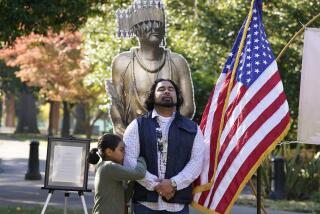Forsaking island paradise for Promised Land : Many Tongans, converted by Mormon missionaries, flock to Utah, where they encounter culture clash.
SALT LAKE CITY â The church is American Colonial style, but the harmony of the chorus clearly is not.
To the beat of heavy drums, three dozen voices are raised in a traditional Tongan chant--a mauluulu-- to celebrate a seminal event in Polynesian-American history: the journey of Mormon pioneers who fled religious persecution to settle Utah in 1847.
âWe ask that they (the Utah pioneers) be blessed because of their hard work. They kept going in their faith and hope and made the (Salt Lake) valley bloom for us,â explained Maatai Siting during a break in the song at the all-Tongan Riverside Ward of the Church of Jesus Christ of Latter-day Saints.
In Tonga, LDS missionaries have done well--so well that one in three Tongans is a Mormon, the highest concentration of Mormons anywhere but Utah.
In Utah, the 12,000-member Tongan community is the stateâs second-largest minority group, trailing only Hispanics.
For many Tongans, the trip to Salt Lake City from their impoverished South Pacific islands east of Australia is both a spiritual journey and economic necessity.
âIf you go to Tonga, right in the middle of the village they have a very beautiful ward (parish) of the Mormon church, surrounded by little huts,â said the Rev. Tevita Eteaki, pastor of the Tongan United Methodist Church here. âThis is their Zion . . . the Promised Land.â
Eteakiâs Methodist church has 500 members, but there are five Tongan-language LDS wards--or parishes--in Utah, each with as many as 400 members, and thousands of other Tongans attend predominantly Anglo wards.
The Tongan attraction to Mormonism is easily explained. Although radically different, both cultures emphasize devotion to community and family and dote on children.
Also, the LDS church offers free schools in Tonga and access to church-owned universities in Hawaii and Utah--a chance at the American Dream.
âThese families, if they had been in Tonga, would have been in worse situation,â said Sela Mapa, a Tongan who teaches English as a second language at an inner-city elementary school. âMost of them would not get jobs. Most of them would be farming or go fishing . . . theyâre better off here, economically.â
Most are still poor by American standards and must string together several minimum-wage jobs to make ends meet. As many as five families may share a single home purchased by pooling resources.
With adults always at work, Tongan teen-agers sometimes drift into street gangs.
âGang affiliation is very attractive to them because of the culture identity,â said Detective Isi Tausinga, one of Salt Lake Cityâs two Tongan-born police officers. âThis place is 94% white. They get caught up with this mess on the street, whatâs happening here in America.â
Tongan Crips are the most visible of Salt Lake Cityâs gangs. Turf fights and drive-by shootings have become common, but even gangs tend to operate by Utah rules: Drug use is rare and most gang members go home early on Saturday night because they have church on Sunday.
Some older Tongans have been notably successful at breaking economic barriers.
In 1973, Filia (Phil) Uipi came to Utah to attend Brigham Young University, and he stayed on to become the stateâs first Tongan attorney and the only ethnic minority now serving in the state House of Representatives.
Tongans are welcome here, he said, noting that his House district is virtually all-Anglo. Native Utahns are more likely to simply ignore ethnic minorities than to actively discriminate against them, he added.
âI donât blame the community for not opening up, but itâs part of the problem,â Uipi said. âA lot of it is our problem, too. We donât know the language.â
Some Tongans say they feel more at home in Utah than in Tonga, where Tongan Mormons are sometimes shunned for ignoring fakatonga , or island culture, and âtrying to be whiteâ by embracing fakapapalangi , the white manâs way.
Tongan tourist guides illustrate the culture clash with photos of LDS missionaries wearing starched white shirts and narrow black ties--over sarongs.
The cultural melange is still more pronounced in Utah. Tongan rugby teams thunder in parks. Although it is discouraged by LDS teaching, men continue the Tongan tradition of all-night sessions where the talk is of women and the drink is a mild anesthetic made of crushed pepper plant root. Funerals, weddings and birthdays are still celebrated with an abandon that unnerves sedate Utahns.
In her South Pacific restaurant, next to a pizza parlor, Leti Lavulo serves up plates of lupulu: spicy beef, onion and taro leaves cooked in coconut milk.
But even as Tongan-born workmen devoured huge plates of traditional fare, Lavulo conceded that few Tongan young people are interested in her menu or the Don Ho-style âTongan country and Westernâ music that blares from the stereo.
âThey want the hamburger,â she said with a laugh.
More to Read
Sign up for The Wild
Weâll help you find the best places to hike, bike and run, as well as the perfect silent spots for meditation and yoga.
You may occasionally receive promotional content from the Los Angeles Times.






